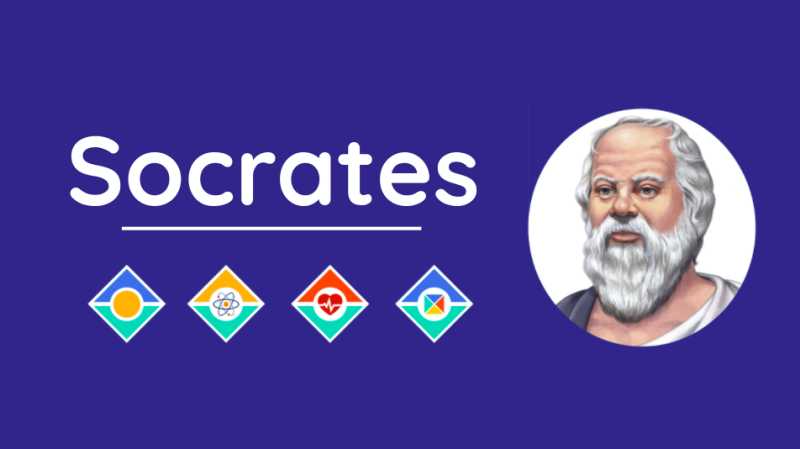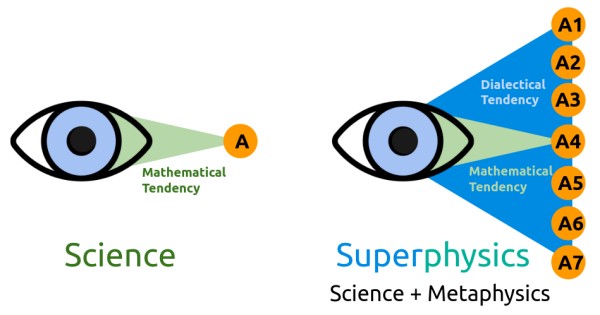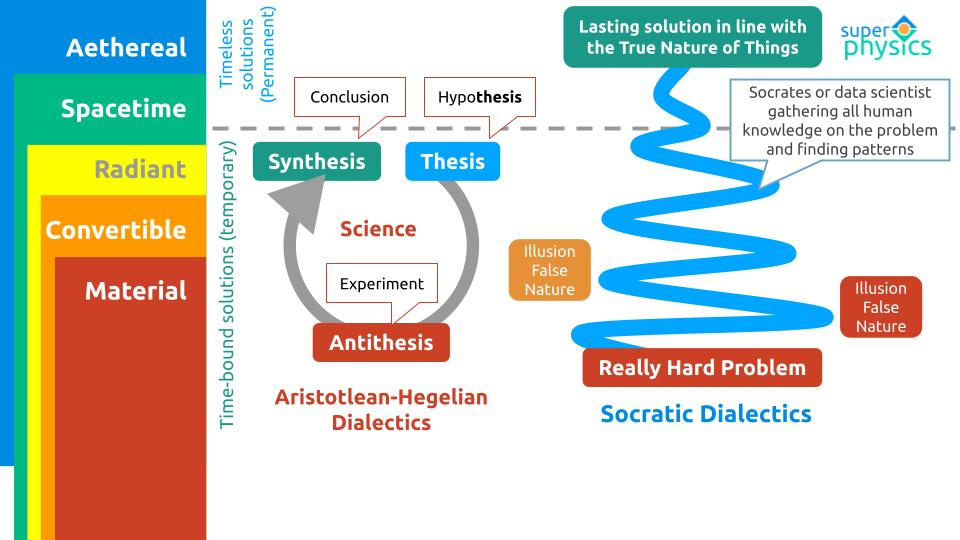What is Socratic Dialectics?
Table of Contents
Principles (click to expand)
| Principle | Assertion |
|---|---|
| The Positive Force is Superior to the Negative | Socratic Dialectics uses the Positive Force to sort through the belligerence of the Positive and Negative within the 5 Layers |
The previous chapter explained Critical Thinking and Critical Feeling.
- Critical thinking is the application of the intellect with added effort in order to push against, or break through, the limitations imposed by the Negative Force
- Critical feeling is the application of the feelings with added effort in order to go outside of the ego or the feeling of the self which is also a result of the Negative Force
These two are used to solve problems.
- Critical thinking is usually for intellectual and physical problems
- Critical feeling is usually for social and psychological ones
Superphysics combines both and packages them around dharma or true nature in order to create a problem-solving tool which we call Socratic Dialectics.
Dialectics is to Nature as Socratic Dialectics is to True Nature
Ordinary Dialectics is an expanded way of analysis that based on the ego.
The Dialectics of Socrates, on the other hand, is a system of analysis based on the invisible metaphysical True Nature or Dharma or Tao* of anything that exists in reality.
Dharma versus Tao versus tao
- “Dharma” is the passive version. An analogy is source code before it is deployed.
- “The Tao” is the active ‘flowing’ version. An analogy is the logic in the app after it is deployed or is online.
Both have reference to metaphysical causes or the Supreme Entity.
- “dharma” and “tao” are the ordinary version in nature.
Similarly, ‘True Nature’ is anchored in something Divine and invisible, while ’nature’ is what is ordinarily inherent.
You could say that:
- Dialectics is from the perspective of the limited self
- Socratic Dialectics is from the perspective of the Universe or Existence or the Totality of Selves* (which the self is a part of).
*The Hindus call this totality as Brahma.
Problems begin when something does not keep in line with its nature. For example:
- loading a pickup truck with 2 tons when it was only designed for 1 ton will cause problems
- eating too much too fast will lead to stomach problems
- installing an app that requires 2GB RAM on a device with only 1GB RAM will lead to errors
Superphysics aims to solve real-world problems by:
- finding the true nature, dharma, or tao of the elements of the problem
- tracing the events or circumstances that caused those elements to veer off of its nature
- suggest ways to get back to that ’natural’ or proper state

Socrates calls this Dharma or Tao as the first principle or True Nature of anything that exists in the physical domain (observable by the five senses). This Dharma, Tao, or True Nature itself resides in the invisible metaphysical domain of ideas and feelings.
You cannot see your ideas and feelings. Instead, you can make them ‘real’ in the physical domain by expressing them physically:
- speaking
- drawing
- acting out
- writing, etc
Dialectic alone goes directly to the first principle. It is the only science which does away with hypotheses in order to make her ground secure. By her gentle aid, she lifts up the eye of the soul which is literally buried in an outlandish slough. She uses as handmaids and helpers the sciences in the work of conversion. Custom calls them sciences. But they should have some other name implying greater clearness than opinion and less clearness than science. We called this “understanding”.
Socrates
The Republic by Plato Simplified, Book 7, Chapter 4
Built to Solve Problems
Unlike spiritual theories which are often useless, Socratic Dialectics is meant to solve real world problems. This makes it more in line with science and technology than philosophy.
The Pythagoreans who have enquired about harmony are as wrong as the astronomers. They investigate the numbers of the harmonies which are heard. But they never apply them to problems. They never reach the natural harmonies of number, or reflect why some numbers are harmonious and others are not.. Their pursuit will be valuable for our objects if all these studies reach the point of inter-communion and connection with one another and become considered in their mutual affinities. Until then, there is no profit in pursuing them.
Socrates
The Republic by Plato Simplified, Book 7, Chapter 4
Science and Math versus Socratic Dialectics and Data Science
Current science is totally based on the physical perceptions of things that already exist. This makes it the opposite of metaphysics which is totally based on invisible perceptions as ideas and feelings.
Archyta invented the Categories. He may be regarded as the founder of ancient Dialectics.
The opinions of Empedocles coincide with those of Aristotle. Empedocles authored the doctrine of the Four Elements. He may be regarded as the founder of [its rival] ancient Physics*.
Adam Smith
Origin of Philosophy Simplified
*Superphysics marries the invisible metaphysics of Archyta with the visible physics of Empedocles.
Science uses math to plot the patterns of its physical perceptions. From those patterns, it tries to work back to the cause.
The problem here is that all causes are metaphysical in nature, since all causes are based on ideas and feelings
- Terrorism is caused by the angry feelings of the terrorist and the idea to use bombs to express his anger
- Supertyphoons are caused by the feelings of heat by the planet as global warming
- Covid is caused by the idea of coronaviruses which are felt as symptoms of coughing, fever, loss of taste, etc. Before science, epidemics were thought to be caused by evil spirits of unknown cause. Both science and non-science are ignorant* of the root cause of such viruses and evil spirits.
*Superphysics places the root cause of such viruses or spirits as coming from stars , just like all matter comes from supernovae (star explosion). This is in line with the ancient 5 Elements model and is what Kepler’s data-driven astrology was trying to prove. Unfortunately, science only took his astronomical observations, as Kepler’s Laws. You could think of stars and supernovae as the ‘deploy’ phase of the aethereal ideas of the Supreme onto reality.
Math, on the other hand, is confined to physical perceptions. The best that math and science can do is to speculate on the causes of problems based on the pattern of effects. It’s like a blind man groping in the dark to discover where he is or what’s around him.
For example, science knows that global warming is caused by greenhouse gas emissions. But it is helpless in actually solving those emissions which is rooted in the love for the causes of emissions:
- the love of eating meat
- the love of electricity and oil
- the love of clearing ugly forests to build beautiful real estate
- and so on

Surely the skilled mathematician is not a dialectician.
Socrates
The Republic Book 7
The Dialectical Upgrade
Dialectics is an upgrade of current science. It not only finds patterns in physical perceptions and facts, but also in metaphysical perceptions as the feelings, opinions, and interpretation of the facts by other minds*.
*Recall that we divided reality into the physical and metaphysical domains . Physical things exist in the former, while metaphysical things, such as ideas and feelings, exist in the latter. Metaphysics is the cause, physics is the effect. The soul is the cause, brain activity is the effect. The chakras are the cause, the hormones are the effect.
Science only deals with the interpetation of a dataset. But Dialectics deals with all possible interpetations of a dataset.
By getting all the data, as well as all the interpretations of the data, then total knowledge is achieved.

But not all data is useful, just as not all interpretations are valid. To solve this, Socratic Dialectics uses wise minds to churn, project, then weed out the bad data and interpretations to preserve only the good and solid ones. Such minds have a more solid grasp of both metaphysics and physics or science and have no bias.
Socrates does this churning process as the Socratic method wherein a wise mind takes an idea from a theorist and then walks forward with the theorist’s mind towards the projected effect of his idea, or backwards in order to discover the cause together.
The natural contradiction between the metaphysical and physical dimensions then manifest as the “contradictions” which Hegel emphasized.
A person will find himself at the top of the intellectual world when he tries to discover the absolute by the light of reason only [via intution], without the help of the senses, and perseveres by pure intelligence until perceives the absolute good [dharma or tao]. This is the same as the sight that has seen the visible. This progress is called dialectic.
Socrates
The Republic by Plato Simplified
Yes but I think that you should go a step further, and consider not only the consequences which flow from a given hypothesis, but also the consequences which flow from denying the hypothesis.
Parmenides
Parmenides by Plato Simplified
Nowadays, this manifests as peer reviews where new theories and interpretations are filtered out by senior academics* who are supposed to have a better grasp of principles.
*In contrast to scientific peer reviews where the academic is a master of material principles, dialectical peer reviews are done by senior metaphysicians (dialecticians) who have a solid grasp of both Eastern and Western metaphysics. Unlike the academic who is verified by a man-made PhD, the seniority of a Socratic dialectician is verified by his track record of predicting things correctly (ideas matching reality).
Inferior theorists, such as Kant, would likely be filtered out by such minds. This explains why Kant attacked Dialectics:
Dialectics is a logic of illusion. It is a sophistical art for giving ignorance and intentional sophistries.. it teaches us nothing regarding the content of our cognitions. It merely shows the formal conditions of their accordance with the understanding, which do not relate to and are quite indifferent in respect of objects. Any attempt to employ it as a tool to extend our knowledge must end in mere nonsense since anyone can oppose any assertion.
Kant
Critique of Pure Reason Simplified, Part 2, Introduction
The distillation of the total knowledge then leads to a single pattern knowledge called principles which form the foundation of Superphysics.
Unlike metaphysical principles which are purely theoretical, the principles must survive in physical reality, either as actual evidence, demonstrations, or successful predictions.
Update: December 2021
Below are examples of real-world evidence.
| Science | Evidence |
|---|---|
| Bio Superphysics | The success of traditional Chinese medicine against Covid, relative to their total lack in the West |
| Economic Superphysics | The correct prediction of the crisis years starting in 2019 onwards, relative to a prediction of a recovery in 2021 from pent-up demand and vaccine success |
| Social Superphysics | The low cases of mass shootings, conflict, and revolutions in Asia, relative to the Americas and Africa |
| Material Superphysics | The prediction that fusion will not work because artificial gravity has not been discovered yet |